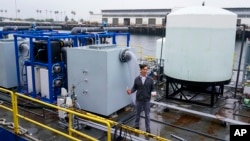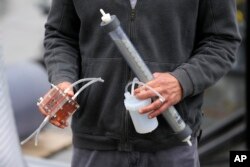American researchers say they have developed a method to remove carbon dioxide (CO2) from the sea and produce a clean-burning fuel in the process.
The method was created by an engineering team at the University of California, Los Angeles. The researchers say the process can be an additional way to help reduce CO2 from the environment to fight the effects of climate change.
Plants and currents in the ocean take in large amounts of CO2 from the atmosphere. The sea is estimated to have drawn in about 30 percent of carbon emissions since the Industrial Revolution, The Associated Press reports.
This process has been a major reducer of carbon and helped protect humanity from the effects of early climate change. But carbon emissions also make oceans more acidic. This can hurt ocean structures, called coral reefs. Reef damage can then harm the growth of many kinds of sea life.
Gaurav Sant is the director of UCLA’s Institute for Carbon Management and helped lead the development project. He told the AP that the technology, called SeaChange, is meant to use the ocean's natural abilities to reduce carbon levels in the sea.
The process sends an electrical charge through seawater flowing through tanks on a large boat. That sets off a series of chemical reactions that turn the carbon emissions into a solid mineral that includes calcium carbonate, the same material seashells are made of. The seawater is then returned to the ocean and can pull more carbon dioxide out of the air. The calcium carbonate settles to the sea floor.
The process has already been demonstrated in California. Researchers are working on plans to begin another project in Singapore. The two projects are expected to be fully operational by 2025. Researchers say they are expected to remove thousands of tons of CO2 per year. If successful, Sant said the plan is to build additional centers to remove millions of tons of carbon each year.
But experts say even if that amount of carbon can be removed, that is still thousands of times less than what will be needed to effectively reduce climate change.
Margaret Leinen is the director of Scripps Institution of Oceanography, an ocean research center in San Diego, California. She told the AP that while the process likely will be effective, she questions how much effect it will have on climate change over a long period.
Sant said an estimated 10 billion metric tons of carbon will need to be removed from the air each year beginning in 2050. He added that the success of such technology will depend on “how fast you can build (the centers) out.”
The UCLA team says at least 1,800 industrial-sized centers would need to capture 10 billion tons of atmospheric carbon dioxide per year. But even smaller amounts could still make a difference.
Researchers from the UCLA Samueli School of Engineering built the demonstration system in two years. The project has received tens of millions of dollars from the U.S. Department of Energy and from private supporters.
Much of the attention on carbon-reducing measures has traditionally been on land-based projects, such as planting trees or building factories to capture carbon from polluters. But those processes have limitations. Scientists have increasingly turned to help from the ocean, which covers 70 percent of the Earth’s surface.
One way the process is different is that it produces hydrogen. Hydrogen is considered a clean-burning fuel that can be used to power vehicles, airplanes, homes and more. To remove one metric ton of carbon dioxide, about 220 metric tons of water needs to flow through the system. Sant said that produces about 35 kilograms of hydrogen.
Sant launched the startup company Equatic to expand the project. The company’s aim is to remove carbon at a cost well below $100 a metric ton. The hydrogen would be produced at less than $1 per kilogram. That is much less than the current cost of cleanly produced hydrogen.
I’m Bryan Lynn.
The Associated Press reported on this story. Bryan Lynn adapted the report for VOA Learning English.
______________________________________________________________
Words in This Story
current – n. the natural flow or air or water in one direction
emission – n. the act of sending out gas, heat, light, etc.
__________________________________________________________________
What do you think of this story? We want to hear from you. We have a new comment system. Here is how it works:
- Write your comment in the box.
- Under the box, you can see four images for social media accounts. They are for Disqus, Facebook, Twitter and Google.
- Click on one image and a box appears. Enter the login for your social media account. Or you may create one on the Disqus system. It is the blue circle with “D” on it. It is free.
Each time you return to comment on the Learning English site, you can use your account and see your comments and replies to them. Our comment policy is here.











Forum